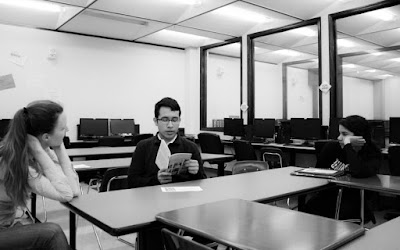yesterday, the labors of our fingertips: poems from manufacturing history in berks county joined a classroom for the first time. discussions of the project were a part of a creative writing class in a weekly mentoring program at the i-lead charter school in the city of reading.
the class, hosted by albright college english instructor marian wolbers, had three students. some questions which came up from the students were about immigrant family histories of the people whose stories led to the creation of these poems, what happened to the businesses for these old jobs, and what is in the buildings now for the places that still exist. in some cases, the buildings were torn down, while in others, they were converted to apartments or became locations of current businesses. and a few are still in operation today.
as a way to mix things up from the norm of past readings and discussions, we tried something new: after hearing a few poems read, students had a chance to pick a number between 9 and 33, which are the page numbers in the first volume of this project for where the poems themselves make homes.
after a student chose a number, another student in the room read the poem on the page matching the picked number.
and marian wolbers offered photography assistance, which is why there are no eye-scenes of her lovely self.
the selected poems by sudden math play were about the work lives of larry miller of boyertown borough (page 14), lester christman of bechtelsville borough (page 12), and helen mengel of maidencreek township (page 11).
miller and christman both knew a life of casket-everything many years ago. born in 1937, miller knew what we walk on everyday and then caskets through the work of his hands. below is an excerpt from his poem in volume one of the labors of our fingertips: poems from manufacturing history in berks county.
*
years ago, they used to nail the heels of shoes into place.
then they went to a paste. my father knew george haddad
well, the president of boyertown shoe corporation, which
had its operation at 225 south washington street. i sewed
the upper part of shoes in the front
near the sole when i worked there,
and my father worked at beckerman
shoe factory a few streets away. he did the same kind
of work as me with the sewing. we made mostly children’s
shoes, 99 percent of it leather, but we never made shoes
for infants. i might have brought home pairs for my little
girl, sometimes. when the plant
moved to allentown, i quit after
a while, less distance. i wanted to be
closer to my family. by 1963, i started at the casket factory
in boyertown, a quarter of a century of my days there,
in the grand math of it all. i buy old signs and reminders
of that place when i can. they told me they had openings
in different departments, but
i wanted to work with wood.
i just liked spraying. that’s
what i did. i had always liked to refinish furniture, so doing
the top coats, sealing, and lacquering the caskets became
a good fit for me. the color, the staining, met surfaces with
a brush. i used an air compressor to spray on the finishing
touches, and the liquid shot
out fast from a tank behind me.
then they went to a paste. my father knew george haddad
well, the president of boyertown shoe corporation, which
had its operation at 225 south washington street. i sewed
the upper part of shoes in the front
near the sole when i worked there,
and my father worked at beckerman
shoe factory a few streets away. he did the same kind
of work as me with the sewing. we made mostly children’s
shoes, 99 percent of it leather, but we never made shoes
for infants. i might have brought home pairs for my little
girl, sometimes. when the plant
moved to allentown, i quit after
a while, less distance. i wanted to be
closer to my family. by 1963, i started at the casket factory
in boyertown, a quarter of a century of my days there,
in the grand math of it all. i buy old signs and reminders
of that place when i can. they told me they had openings
in different departments, but
i wanted to work with wood.
i just liked spraying. that’s
what i did. i had always liked to refinish furniture, so doing
the top coats, sealing, and lacquering the caskets became
a good fit for me. the color, the staining, met surfaces with
a brush. i used an air compressor to spray on the finishing
touches, and the liquid shot
out fast from a tank behind me.
*
( larry miller next to an antique gas pump because he loves
reminders of old days; an artifact from casket factory days )








No comments:
Post a Comment